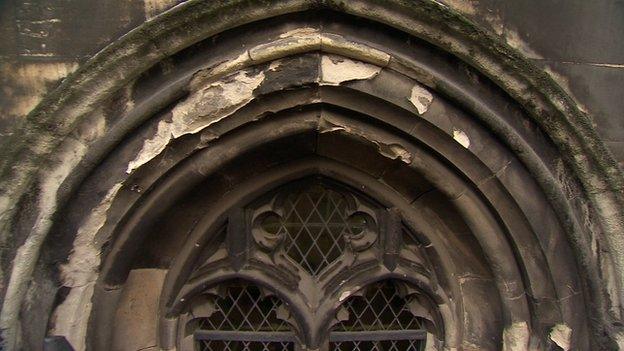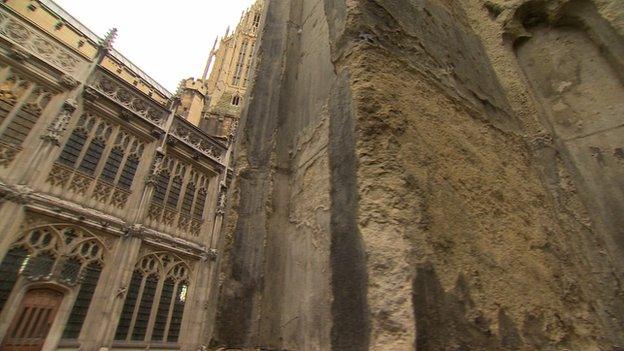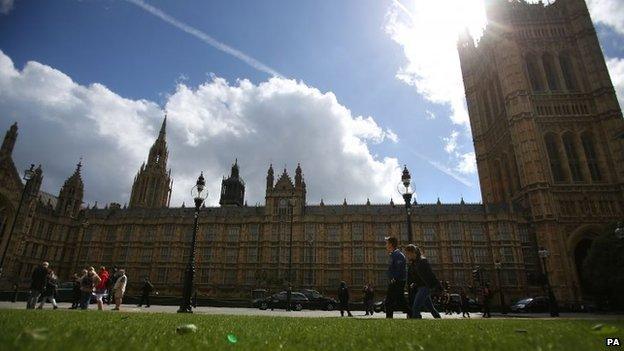Parliament repair bill 'could top £3bn'
- Published
Laura Kuenssberg's exclusive report from the Palace of Westminster in 2014
Taxpayers may have to spend more than £3bn to stop Parliament turning into an unusable "ruin", Newsnight understands.
The Palace of Westminster has seen fire and floods, some stonework is badly damaged and much of the infrastructure has not been updated since the 1950s.
Restoring it will be "embarrassing, expensive and difficult", a senior insider said.
No final decisions have been taken, but an option under consideration is moving MPs and peers out for five years.
Leaking pipes
Some parts of the façade of Westminster Hall are so fragile they can be crumbled off easily with a hand.
The basements underneath the historic building are full of asbestos, leaking pipes and miles and miles of outdated wiring and cables.
The annual maintenance bill is about £30m.
Newsnight, which was given exclusive access to parts of the palace never seen by the public, has been told by several well-placed sources that the "working assumption" of the cost of restoration is £3bn.
That's considerably more than other estimates previously released.

The stone facade of Westminster Hall crumbles to the touch
A source familiar with the project said: "I'd be surprised if it stayed at that."
Richard Ware, the director of the "Restoration and Renewal" project, said the work was urgent.
"We're moving backwards. The building is getting older, faster than we can deal with it," he said.
"The building is on borrowed time and, if we don't act soon, we won't have a choice."
'Sinking and crumbling'
He warned that if nothing was done, politicians and staff would end up "working in a ruin".
Cloister Court, part of the building dating back to the 14th Century, is "sinking and crumbling", according to Adam Watrobski, Parliament's principal architect.
Gargoyles and stone facades have been disfigured by decades of pollution.

Stonework is badly disfigured in many areas
An initial, independent report has been completed, considering and costing three main options:
Moving MPs and peers out completely for five years, closing the entire Palace of Westminster. This would be expected to encounter significant political opposition
A "partial decant" - the House of Lords and the House of Commons would move out in turn, so one half of the palace could be restored at a time, which would take considerably longer
Politicians refuse to move and construction takes place around them. That could take decades and cost even more
The parliamentary authorities have decided not to publish the report until next summer.
'National identity'
They are reluctant to make the cost of the building an issue in the run-up to the general election and are expected to commission more research instead.
Sources emphasise that, at this stage, no final decision has been taken about the preferred option or final cost.
Mr Ware accepts the cost may be well over the most recent estimates of about £1.6bn, but won't yet divulge what the final figure might be.
There will inevitably be controversy about the costs.
But historian and architectural expert Dan Cruickshank believes the Palace of Westminster "it's one of the great buildings of the world".
He added: "It represents in many ways the national identity of Britain... it has to be done properly.

An independent quango is likely to manage the restoration project
"It has to be a model of how to make a historic building work for the 21st Century."
Newsnight also understands that an independent quango, similar to the Olympic Delivery Authority that was in charge of the 2012 Olympics, is likely to be set up to manage the project.
The decisions, which may need legislation, will have to be made soon after the general election next year.
The most likely start date for the actual restoration is 2021, so that MPs elected in the 2020 election would be able to sit in the Commons for 12 months before potentially having to move out.
Sources predict that the decisions around cost and moving politicians are likely to be a "real battle", storing up trouble for MPs after next May.